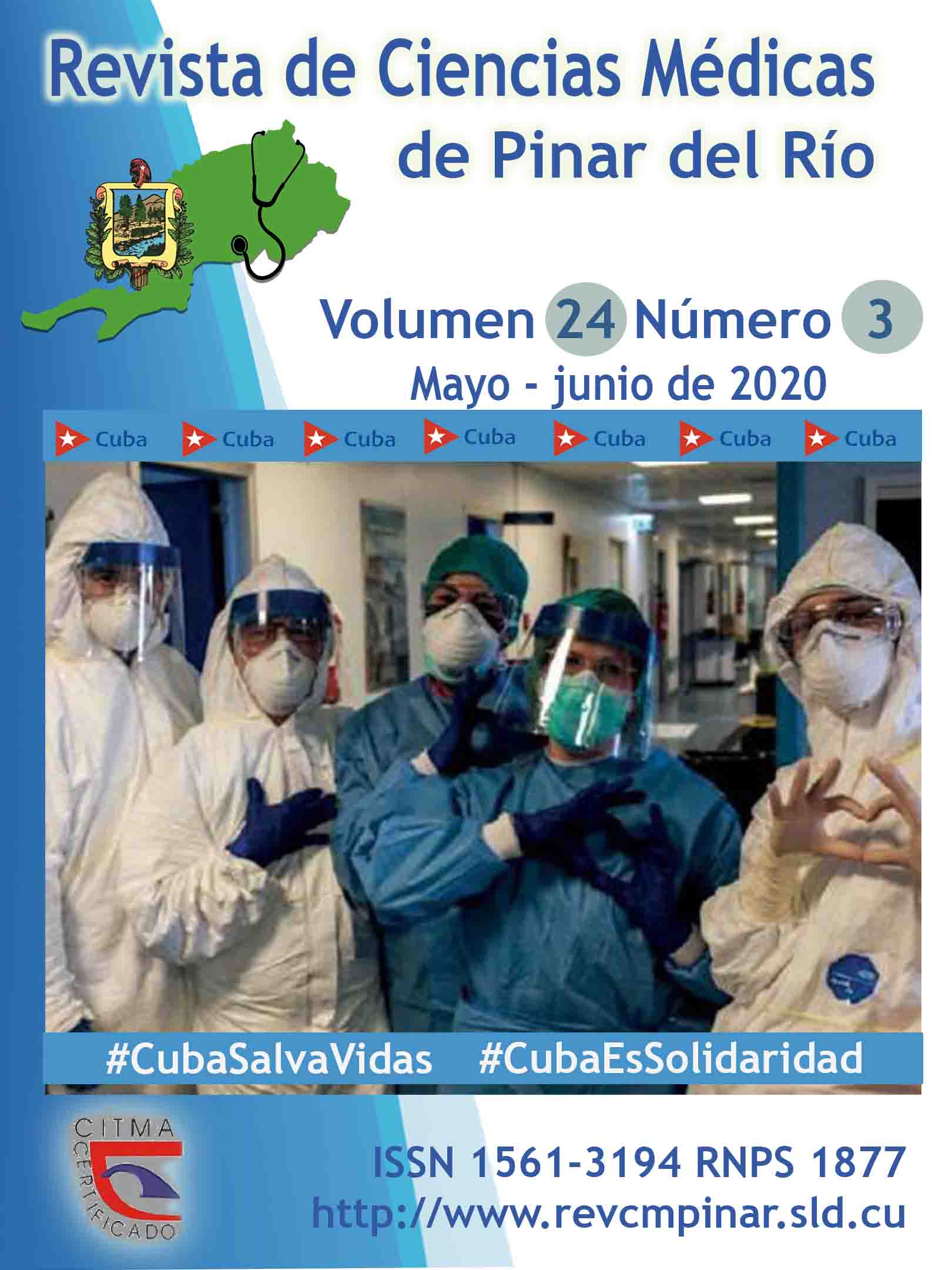Clinical and epidemiological characterization of patients with permanent pacemaker implants
Keywords:
PERMANENTS PACEMAKER, ELECTRICAL STIMULATION, PACEMAKER, SICK SINUS NODE AND ATRIOVENTRICULAR BLOCKAbstract
Introduction: the implantation of permanent pacemakers follows an upward trend in recent years. The increase in life expectancy implies a higher incidence of degenerative diseases, which cause most implants.
Objective: to characterize clinical and epidemiologically patients with permanent pacemaker implantation in Cardiology Service at Celia Sánchez Manduley Hospital from January 2017 - December 2018.
Methods: a descriptive, cross-sectional and retrospective study in patients with permanent pacemakers implantations in the Cardiology Service at Celia Sánchez Manduley Hospital from January 2017 to December 2018. The study population comprised 132 patients who underwent this procedure. Absolute frequency, arithmetic mean with standard deviation and percentage calculation were performed.
Results: the most affected age group was 81-90 (38,6 %) and male sex (52,2 %). The most used route was cephalic vein dissection (52,2 %) and the predominant surgical time was 1 to 2 hours in 60,5 %. There was a prevalence of patients with syncope (58,3%). Thirty-one percent of the indications were for third-degree atrioventricular block. The most frequent complication was infection.
Conclusions: permanent pacemakers was more frequent implanted in men and in patients between 81 and 90 years old. The most used route was the cephalic vein. The procedure lasted one to two hours. The most frequent cause for admission was syncope. The main indication was in the third degree atrioventricular block. Infection was the most frequent of the complications.
Downloads
References
1. Pérez Ortega S, Vidorreta Gracia S, Casal Rodríguez J, Eseverri Rovira MM, Vivas Tovar ME. Estancia y complicaciones de los pacientes con implantes no electivos de marcapasos. Enferm Cardiol [Internet]. 2012 [citado 01/02/2020]; (55-56): [aprox. 4p.]. Disponible en: https://www.enfermeriaencardiologia.com/wp-content/uploads/55_56_15.pdf
2. Santos Monzón Y, Mata Cuevas A, Rodríguez León A, Pérez González JA, Díaz Águila H. Comportamiento de la estimulación eléctrica en el municipio de Sagua la Grande en el período 2005-2011. Cor Salud [Internet]. 2013 [citado 01/02/2020]; 5(3): [aprox. 4p.]. Disponible en: http://www.revcorsalud.sld.cu/index.php/cors/article/view/526
3. Echazabal Leal M, Cruz Sosa R, Hernández De León N, Díaz Naranjo J. Características clínicas de pacientes que recibieron implante, reimplante o cambio de generador de marcapasos permanentes. Revista Finlay [Internet]. 2018 dic [citado 01/02/2020]; 8(4): [aprox. 8p.]. Disponible en: http://scielo.sld.cu/scielo.php?script=sci_arttext&pid=S2221-24342018000400007&lng=es.
4. Secaira Neira BE, Espinosa Martin L, Solano Noblecilla JJ. Implantación de marcapasos permanentes en Cuenca-Ecuador, 2017-2018. Revista Latinoamericana de Hipertensión [Internet]. 2019 [citado 01/02/2020]; 14(2): [aprox. 4p.]. Disponible en: http://190.169.30.98/ojs/index.php/rev_lh/article/view/16343
5. Cano Pérez O, Pombo Jiménez M, Lorente Carreño D, Chimeno García J. Registro Español de Marcapasos. XVI Informe Oficial de la Sección de Estimulación Cardiaca de la Sociedad Española de Cardiología. Rev Esp Cardiol [Internet]. 2019 [citado 03/02/2020]; 72(11): [aprox. 11p.]. Disponible en: https://www.revespcardiol.org/es-registro-espanol-marcapasos-xvi-informe-articulo-S0300893219303173
6. Izaguirre S. Implantación de marcapasos en la unidad de cuidados coronarios. Estudio realizado en el Hospital Teodoro Maldonado, año 2016. [Tesis]. Ecuador: Universidad de Guayaquil, Facultad de Ciencias Médicas; 2017. http://repositorio.ug.edu.ec/handle/redug/32271
7. Cano Pérez O, Pombo Jiménez M, Coma Samartín R. Registro Español de Marcapasos. XII Informe Oficial de la Sección de Estimulación Cardiaca de la Sociedad Española de Cardiología. Rev Esp Cardiol [Internet]. 2015 [citado 01/02/2020]; 68(12): [aprox. 15p.]. Disponible en: https://www.revespcardiol.org/es-registro-espanol-marcapasos-xiiinforme-oficial-articulo-S0300893215005138
8. Torrealba Ramírez RV. Caracterización y Perfil Farmacológico de los pacientes portadores de marcapasos en el Hospital Roberto Calderón Gutiérrez durante el periodo 2012-2016. [Tesis]. Nicaragua: Universidad Nacional Autónoma de Nicaragua; 2017. https://repositorio.unan.edu.ni/4352/
9. Casola Crespo R, Casola Crespo E, Ramírez Lana LJ, Miranda Fragoso AE, Casola García SM. Registro de implante de marcapasos: trece años de experiencia. Rev. Arch Med Camagüey [Internet]. 2016 [citado 01/02/2020]; 20(2): [aprox. 9p.]. Disponible en: http://scielo.sld.cu/scielo.php?script=sci_arttext&pid=S1025-02552016000200006&lng=es
10. Núñez Sánchez CA, Pineda Chávez LE. Prevalencia de implantación de marcapasos permanentes y sus complicaciones en el Hospital de Especialidades Guayaquil Dr. Abel Gilbert Pontón, durante el periodo Enero – Diciembre 2016. [Tesis]. Ecuador: Universidad Católica de Santiago de Guayaquil; 2017. http://repositorio.ucsg.edu.ec/handle/3317/8036
11. Pombo Jiménez M, Cano Pérez O, Lorente Carreño D, Chimeno García J. Registro Español de Marcapasos. XV Informe Oficial de la Sección de Estimulación Cardiaca de la Sociedad Española de Cardiología. Rev Esp Cardiol. [Internet]. 2018 [citado 03/02/2020]; 71(12): [aprox. 9p.]. Disponible en: https://www.revespcardiol.org/es-registro-espanol-marcapasos-xv-informe-articulo-S0300893218304731
12. Ruiz Arquinigo E. Perfil clínico y modos de estimulación en pacientes con implante de marcapaso Hospital Alberto Sabogal Sologuren De Essalud 2011-2014. [Tesis]. Perú: Facultad de Medicina Humana; 2015. http://www.repositorioacademico.usmp.edu.pe/handle/usmp/1211?show=full
13. Cano Pérez O, Pombo Jiménez M, Fidalgo Andrés ML, Lorente Carreño D, Coma Samartín R. Registro Español de Marcapasos. XIV Informe Oficial de la Sección de Estimulación Cardiaca de la Sociedad Española de Cardiología. Rev Esp Cardiol [Internet]. 2017 [citado 03/02/2020]; 70(12): [aprox. 14p.]. Disponible en: https://www.revespcardiol.org/es-registro-espanol-marcapasos-xiv-informe-articulo-S0300893217305134
Downloads
Published
How to Cite
Issue
Section
License
Authors who have publications with this journal agree to the following terms: Authors will retain their copyrights and grant the journal the right of first publication of their work, which will be publication of their work, which will be simultaneously subject to the Creative Commons Attribution License (CC-BY-NC 4.0) that allows third parties to share the work as long as its author and first publication in this journal are indicated.
Authors may adopt other non-exclusive license agreements for distribution of the published version of the work (e.g.: deposit it in an institutional telematic archive or publish it in a volume). Likewise, and according to the recommendations of the Medical Sciences Editorial (ECIMED), authors must declare in each article their contribution according to the CRediT taxonomy (contributor roles). This taxonomy includes 14 roles, which can be used to represent the tasks typically performed by contributors in scientific academic production. It should be consulted in monograph) whenever initial publication in this journal is indicated. Authors are allowed and encouraged to disseminate their work through the Internet (e.g., in institutional telematic archives or on their web page) before and during the submission process, which may produce interesting exchanges and increase citations of the published work. (See The effect of open access). https://casrai.org/credit/



